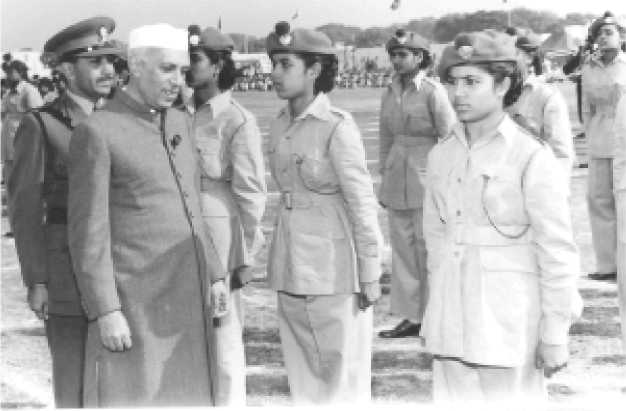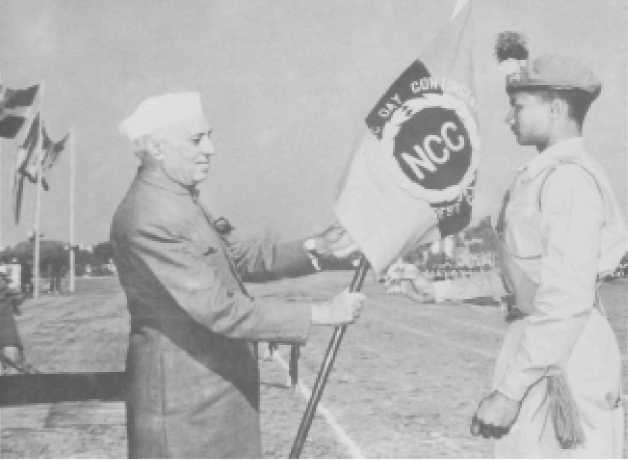Government Polytechnic, Ahmedabad has a total strength of 117 NCC cadets. Senior Division cadets (62) are affiliated with 1 Guj Compo (Tech) NCC, Ahmedabad and Senior Wing cadets (55) are affiliated with 1 Guj Girls Bn NCC, Ahmedabad
Character, Comradeship, Discipline, Leadership, Secular Outlook, Spirit of Adventure, and Ideals of Selfless Service amongst the Youth of the Country.
Fa Human Resource of Organized, Trained and Motivated Youth, To Provide Leadership in all Walks of life and be Always Available for the Service of the Nation.
a Suitable Environment to Motivate the Youth to Take Up a Career in the Armed Forces.
The NCC is a responsive, learning and continuously evolving organization. Its activity is guided by certain Core Values that we endeavour to instill among all ranks of the NCC. These include the following:
The Cadet Corps Committee which was formed on 29 Sep 1946 with Pt HN Kunzru as chairman held six meetings in South Block, New Delhi. At the same time, Pt HN Kunzru formed sub-committees which were sent on study tours in all the main provinces of pre-independent India including provinces which are now located in Bangladesh and Pakistan. One sub-committee was also sent on tour to Great Britain and France from 15 Feb 1947 to 31 Mar 1947 to study the Youth and Cadet organisations in those countries.
The Cadet Corps Committee carried out exhaustive study of the problem of youth in India. Its sub-committees after their tour at home and abroad submitted their report to the Govt of India in Mar 1947. Soon after the report was submitted, a far reaching political development began to impact the country, due to which the Cadet Corps Scheme had to be kept in abeyance. The religious strife which then was at its zenith, ultimately led to the partition of the country into India and Pakistan.
On the stroke of midnight of 14/15 Aug 1947, India achieved her independence. Immediately after independence, India was confronted with problems of formidable magnitude concerning not only repatriation of millions of displaced persons from Pakistan but also a full scale invasion of Kashmir by the armed tribesmen supported by Pakistan. The armed forces had to rush to retrieve Kashmir at a time when they were already pre-occupied with the internal problem of maintaining law and order during the country’s initial stage of consolidation.
The war in Kashmir and the consequent loss of a portion of Indian territory; the open support of Western Powers to Pakistan in the Security Council of the United Nations, made it more than evident to the Indian leaders that they not only had to strengthen the Armed Forces but also create sufficient strength of reserves, who could take up arms, when required. The gravity of time and event found expression in the Indian Legislature through anxious and pressing demand for military training of young men and women throughout the country.

At this juncture, Prime Minister Pt Jawahar Lal Nehru at the behest of Sardar Baldev Singh, the then Defence Minister and Sardar Vallabhbhai Patel, then Home Minister, took out the Kunzuru Committee Report for a serious studyfrom the shelves of the Defence Department. On 05 Dec 1947, after being approved by the Defence Committee the copy of the Cadet Corps Committee Report was sent to the Chief Secretaries and Chief Commissioners of all Provincial Govts (now called State Govts) for their comments. The consent of Provincial Govts were required because they were responsible for the administration of the educational institutions in their respective provinces and thus the success of the Cadet Corps scheme largely depended on their initiative. Replies received from the provinces in Jan 1948, show that they all agreed in principal with the Cadet Corps Scheme submitted by the Kunzuru Committee.

The Kashmir War of 1948 taught a very important lesson to India, that freedom needs to be protected by strong Armed Forces. Its immediate manifestation was that the recommendations of Kunzuru committee were placed before the Constituent Assembly (Legislature) on 13 Mar 1948. A draft Bill was sent to the Constituent Assembly (Legislative) on 19 Mar 1948, which evoked great interest and enthusiasm amongst all members. After due deliberations and amendments, the Bill was passed by the Assembly on 08 Apr 1948. The Central Govt accepted the opinion of the Provincial Govts and the Standing Committee’s recommendations for the formation of a Cadet Corps which was to be named as “National Cadet Corps”, as recommended by the Kunzuru Committee.
The Bill received the assent of the Governor General on 16 Apr 1948, and the National Cadet Corps came into being by an Act of the Parliament Act No. XXXI of 1948 designated ‘The National Cadet Corps Act 1948’. This Act with 13 clauses, prescribed the formation of the National Cadet Corps in India.
The first step in the process of raising of the NCC was setting up of the NCC Secretariat now called Headquarters Directorate General NCC. In fact, even before the NCC Bill was passed by the Constituent Assembly (Legislative), the Ministry of Defence had set up the nucleus of the NCC Secretariat, with Col (later retired as Chief of Army Staff) Gopal Gurunath Bewoor as first Director of the NCC. He took over as Director of NCC on 31 Mar 1948.
The schools and colleges opened after summer vacation and the NCC of Independent India was inaugurated on 15 Jul 1948. The journey of this Indian youth organization, which has now become the largest uniformed youth organization in the world had begun.
In the year 1948 a total of 96 units of Senior Division were raised, comprising variety of units to include one Armoured Corps, three Artillery, five Engineers, two Signals and two Medical – and 83 companies of Infantry. As there was some delay in the establishment of NCC in UP, Madras and Bihar, whose Govts wanted every student joining NCC to be verified by police prior to enrolment, only 20,000 cadets had joined the NCC in the year 1948. The raising of the Junior Division units did not progress well owing to shortage of trained school teachers. The main difficulty was that adequate number of teachers of the desired quality did not come forward to work as NCC officers. There were various administrative reasons attributed to this. Sometimes, colleges and schools were not in a position to spare the teaching staff except during the summer vacation. Thus, the NCC which has now 14 lakh cadets on its rolls, had started with 20,000 cadets in 1948.

